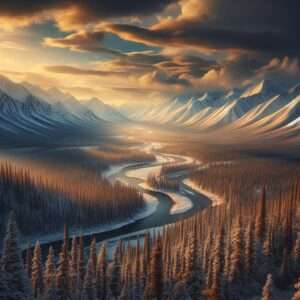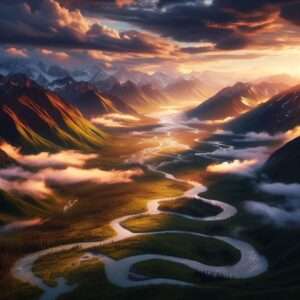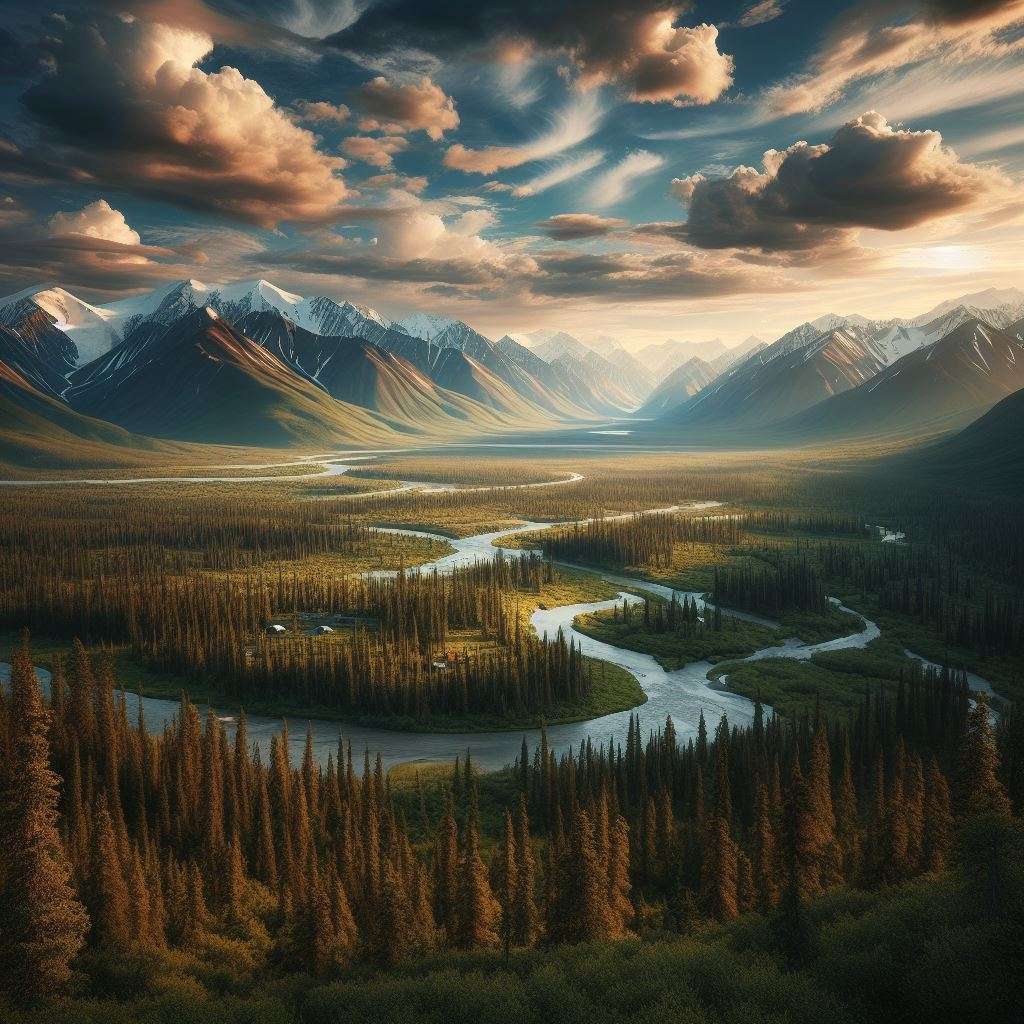Discover the Untouched Beauty of Kobuk Valley National Park: 7 Reasons to Explore Alaska’s Hidden Gem
Introduction
Hey there, adventure seekers! Get ready to embark on a journey into the heart of untamed wilderness as we dive into the captivating beauty of Kobuk Valley National Park. Tucked away in the remote corners of Alaska, this hidden gem is a nature lover’s dream come true. Imagine vast stretches of rolling sand dunes, caribou herds migrating across the tundra, and the mystical allure of the Arctic Circle – all within the boundaries of this incredible national park.
But wait, there’s more! Kobuk Valley isn’t your typical national park experience. This is a place where nature takes the lead, showcasing its raw, unbridled power and majesty. From the mesmerizing boreal forests to the awe-inspiring Great Kobuk Sand Dunes, every step you take is a step into the unknown, a moment to connect with the wild in its purest form.
So, why should you pack your bags and head to Kobuk Valley National Park? In this blog, we’ll unravel the mysteries of this remote wonderland, share insider tips for an unforgettable adventure, and inspire you to embrace the spirit of exploration. Buckle up, fellow wanderers – Kobuk Valley awaits, and the tales we’re about to tell will undoubtedly ignite your passion for the great outdoors!
Attractions in kobuk Valley National Park:
Displayed in the table below are the leading 25 attractions within Kobuk Valley National Park, highlighting distinctive features that distinguish each site and render it remarkable.
| # | Attraction | What’s Special |
|---|---|---|
| 1 | Kobuk River | Wild and scenic river with diverse wildlife. |
| 2 | Great Kobuk Sand Dunes | Largest active sand dunes in the Arctic. |
| 3 | Kotzebue Eskimo Village | Opportunity to experience native Alaskan culture. |
| 4 | Salmon River | Important salmon migration route. |
| 5 | Kobuk Valley Overlook | Breathtaking views of the surrounding wilderness. |
| 6 | Tundra Hiking Trails | Explore the vast Arctic tundra on designated trails. |
| 7 | Hunt River | Scenic river with opportunities for boating. |
| 8 | Onion Portage Archaeological Site | Historical site with artifacts dating back thousands of years. |
| 9 | Little Kobuk River | Tranquil river known for its serene surroundings. |
| 10 | Walker Lake | Remote lake with scenic beauty and birdwatching opportunities. |
| 11 | Arrigetch Peaks | Majestic mountain range in the park. |
| 12 | Aurora Borealis Viewing | Opportunity to witness the mesmerizing Northern Lights. |
| 13 | Kobuk Valley Wilderness | Expansive wilderness with diverse ecosystems. |
| 14 | Baird Mountains | Mountain range providing a stunning backdrop. |
| 15 | Alagnak Wild River | Designated wild river for a pristine kayaking experience. |
| 16 | Marsh Fork | Scenic area with opportunities for wildlife observation. |
| 17 | Kotzebue Sound | Coastal area with marine life and birdwatching. |
| 18 | Nash Harbor | Fishing destination with stunning coastal views. |
| 19 | Alatna River | River offering wilderness float trips. |
| 20 | Kobuk Valley Flora | Explore the unique plant life of the Arctic region. |
| 21 | Salmon Lake | Remote lake with opportunities for fishing. |
| 22 | Boreal Forests | Discover the diverse ecosystems of the park’s forests. |
| 23 | Shungnak | Visit the nearby Inupiaq Eskimo village. |
| 24 | Bendeleben Mountains | Mountain range providing a scenic backdrop to the wilderness. |
| 25 | Kobuk Valley National Park Visitors Center | Hub for park information and ranger-led programs. |

Introduction to Kobuk Valley National Park:
What is Kobuk Valley National Park?
Kobuk Valley National Park is a vast expanse of untamed wilderness located in the remote corners of Alaska. Encompassing 1.7 million acres, it offers a unique and secluded experience for nature enthusiasts. From rolling sand dunes to expansive boreal forests, Kobuk Valley captivates visitors with its diverse landscapes. This national park stands as a sanctuary for various plant and animal species, providing an authentic connection with the wild. As one of the least-visited national parks in the United States, Kobuk Valley beckons adventurers seeking an off-the-beaten-path exploration in the heart of the Arctic Circle.
Where is Kobuk Valley National Park located?
Kobuk Valley National Park is situated in the northwestern part of Alaska, within the Arctic Circle. Its remote location contributes to the park’s pristine and untouched natural environment. The park’s coordinates place it in the midst of the Arctic wilderness, creating a unique climate and ecosystem that sets it apart from other national parks in the country.
How big is Kobuk Valley National Park?
Kobuk Valley National Park spans an impressive 1.7 million acres, making it one of the larger national parks in the United States. This vast expanse encompasses diverse ecosystems, including boreal forests, tundra, and the iconic Great Kobuk Sand Dunes. The sheer size of the park contributes to its unique appeal, providing ample opportunities for exploration and discovery.
Kobuk Valley National Park Features:
What are some facts about Kobuk Valley ?
Kobuk Valley National Park boasts several fascinating facts that contribute to its allure. Apart from being home to the Great Kobuk Sand Dunes, one of the largest active sand dune systems in North America, the park hosts the annual migration of the Western Arctic Caribou Herd, a natural spectacle attracting wildlife enthusiasts. The diverse ecosystems within the park, including boreal forests and tundra, add to its ecological significance.
What animals can be found in Kobuk Valley ?
Kobuk Valley National Park is home to a diverse array of wildlife, showcasing the richness of its ecosystems. Caribou, grizzly bears, wolves, Dall’s sheep, and a variety of bird species inhabit the park. The interconnected web of life in Kobuk Valley provides ample opportunities for wildlife enthusiasts to observe and appreciate the untamed beauty of these natural habitats.
Are caribou present in Kobuk Valley ?
Absolutely! Kobuk Valley National Park is renowned for hosting the annual migration of the Western Arctic Caribou Herd. This mesmerizing spectacle involves thousands of caribou moving across the park’s landscape in search of food and breeding grounds. Witnessing this natural phenomenon is a highlight for visitors, adding a unique and unforgettable dimension to the Kobuk Valley experience.
Tell me about the wildlife in Kobuk Valley .
The wildlife in Kobuk Valley National Park is both diverse and abundant, contributing to the park’s ecological significance. Caribou, with their annual migration, steal the spotlight, but the park is also home to grizzly bears, wolves, moose, and a variety of bird species. Exploring the park provides opportunities for wildlife observation, allowing visitors to connect with the untamed nature of this Alaskan wilderness.
What plant life exists in Kobuk Valley ?
Kobuk Valley National Park supports a range of plant life, adapting to its varied ecosystems. Boreal forests dominate parts of the park, featuring spruce and birch trees, while the tundra regions showcase hardy vegetation adapted to the Arctic environment. The sand dunes, a unique feature of the park, host specialized plant species that have evolved to thrive in the challenging conditions of shifting sands.
Besides caribou migration, what else is Kobuk Valley known for?
In addition to the awe-inspiring caribou migration, Kobuk Valley National Park is known for the Great Kobuk Sand Dunes. These massive sand dunes, some reaching heights of 100 feet, create a surreal landscape that contrasts with the surrounding Arctic environment. The park’s diverse ecosystems, including boreal forests and tundra, further contribute to its reputation as a multifaceted natural wonder.

Visiting Kobuk Valley National Park:
How do I get to Kobuk Valley National Park?
Accessing Kobuk Valley National Park involves careful planning due to its remote location. There are no roads leading directly to the park, so most visitors opt for a combination of air and river travel. Commercial airlines connect major cities like Anchorage to nearby villages, and from there, bush planes or charters can transport you to the park. Additionally, some adventurers choose to embark on multi-day river trips along the Kobuk River, offering a unique and immersive approach to reaching this remote destination.
Where can I find the Kobuk Valley National Park visitor center?
Kobuk Valley National Park does not have a traditional visitor center like many other national parks. Instead, visitors can find information and assistance at the Northwest Arctic Heritage Center in Kotzebue, a nearby town that serves as a gateway to the park. Here, you can gather essential details about the park, including maps, safety information, and updates on weather conditions, ensuring a well-prepared and enjoyable visit.
Are there guided tours available in Kobuk Valley National Park?
While Kobuk Valley National Park is known for its remote and unspoiled nature, there are limited guided tour options available, particularly during the summer months. These tours typically focus on specific aspects of the park, such as the Great Kobuk Sand Dunes or wildlife observation. Engaging with knowledgeable guides enhances the overall experience, providing insights into the park’s ecology, history, and unique features.
What are people saying in Kobuk Valley National Park reviews?
Visitors to Kobuk Valley National Park often rave about the park’s pristine beauty and the sense of solitude it offers. Reviews highlight the unique opportunity to witness caribou migrations, explore vast sand dunes, and immerse oneself in the tranquility of the Arctic landscape. Many appreciate the limited human impact on the environment, making it a true escape into the heart of nature.
Can I see pictures of Kobuk Valley National Park?
Certainly! Photos of Kobuk Valley National Park showcase its stunning landscapes, diverse ecosystems, and unique features. From the vast sand dunes to wildlife in their natural habitats, each photo captures the essence of this remote wilderness. Exploring online platforms, official park websites, and nature photography forums provides a visual journey into the captivating beauty of Kobuk Valley.
How big is Kobuk Valley National Park?
Kobuk Valley National Park spans an impressive 1.7 million acres, making it one of the larger national parks in the United States. This vast expanse encompasses a diverse range of ecosystems, including boreal forests, tundra, and the iconic Great Kobuk Sand Dunes. The sheer size of the park contributes to its unique appeal, providing ample opportunities for exploration and discovery.
Is Kobuk Valley National Park in Alaska?
Yes, Kobuk Valley National Park is located in the state of Alaska, USA. Its remote position in the northwestern part of the state contributes to its pristine and untouched natural environment. The Arctic Circle encompasses the park, adding to its unique climate and ecological characteristics.
Which other national parks are near Kobuk Valley National Park?
Kobuk Valley National Park is somewhat isolated, and its proximity to other national parks is limited. The sheer vastness of Alaska’s wilderness surrounds it, offering a unique experience separate from more accessible parks. However, neighboring natural wonders, such as the Noatak National Preserve and Gates of the Arctic National Park and Preserve, contribute to the overall richness of the region.
How can I plan a visit to Kobuk Valley National Park?
Planning a visit to Kobuk Valley National Park requires careful consideration due to its remote location and limited infrastructure. Start by researching transportation options, considering air travel to nearby villages and connecting with bush planes or river trips. Ensure you have the necessary permits, check weather conditions, and be prepared for the challenges of exploring a wilderness area.
What are the things to do in Kobuk Valley National Park?
Kobuk Valley National Park offers a range of activities for nature enthusiasts and adventure seekers. From hiking and wildlife observation to river trips and camping, the park provides a diverse set of experiences. The Great Kobuk Sand Dunes are a highlight, offering a surreal landscape for exploration. Visitors can also witness the unique phenomenon of caribou migrations, adding a touch of wildlife spectacle to their adventure.
Can I rent an RV for my Kobuk Valley National Park visit?
Yes, renting an RV is a viable option for exploring Kobuk Valley National Park. While there are no RV facilities within the park itself, the freedom of having a mobile base allows visitors to traverse nearby areas and enjoy the journey to the park. Rental options can be found in larger towns or cities in Alaska, providing flexibility for those seeking a more independent and immersive experience.
What are some facts about Kobuk Valley National Park?
Kobuk Valley National Park boasts several fascinating facts that contribute to its allure. Apart from being home to the Great Kobuk Sand Dunes, one of the largest active sand dune systems in North America, the park hosts the annual migration of the Western Arctic Caribou Herd, a natural spectacle attracting wildlife enthusiasts. The diverse ecosystems within the park, including boreal forests and tundra, add to its ecological significance.
Share some fun facts about Kobuk Valley National Park.
Delving into the fun facts of Kobuk Valley National Park reveals its uniqueness and ecological wonders. Did you know that the sand dunes in the park can reach heights of up to 100 feet? Additionally, the caribou migration, involving thousands of animals, is a marvel of nature that occurs within the park’s boundaries. These fun facts contribute to the park’s reputation as a captivating and dynamic natural environment.
What is the closest town to Kobuk Valley National Park?
The closest town to Kobuk Valley National Park is Kotzebue, serving as a gateway for visitors. Located approximately 30 miles from the park, Kotzebue provides essential services, accommodations, and access to transportation. This town is a practical starting point for those planning to venture into the remote wilderness of Kobuk Valley, offering logistical support for an unforgettable Alaskan adventure.
Weather and Winter Experience:
How is the weather in Kobuk Valley National Park?
The weather in Kobuk Valley National Park experiences the characteristic conditions of the Arctic region. Summers are short, with temperatures ranging from 40 to 70 degrees Fahrenheit, providing a brief window for exploration. Winters are harsh, with temperatures often dropping well below freezing. Visitors should be prepared for extreme weather conditions and plan their trips accordingly to make the most of their Kobuk Valley experience.
What’s the experience like during winter in Kobuk Valley National Park?
Winter in Kobuk Valley National Park transforms the landscape into a pristine, snow-covered wonderland. While access becomes more challenging due to extreme weather conditions, those seeking a unique and adventurous experience can explore the park through guided winter excursions. Snowshoeing, cross-country skiing, and witnessing the Northern Lights are some of the extraordinary experiences winter visitors can enjoy in Kobuk Valley.
Are there any lodges near Kobuk Valley National Park?
Lodging options near Kobuk Valley National Park are limited due to its remote location. Visitors often find accommodations in the nearby town of Kotzebue, which offers hotels, inns, and guesthouses. While there may not be lodges directly within the park, Kotzebue serves as a practical base for those looking to embark on their Kobuk Valley adventure with the necessary amenities and services.

You may also consider discovering information about Grand Teton National Park.

